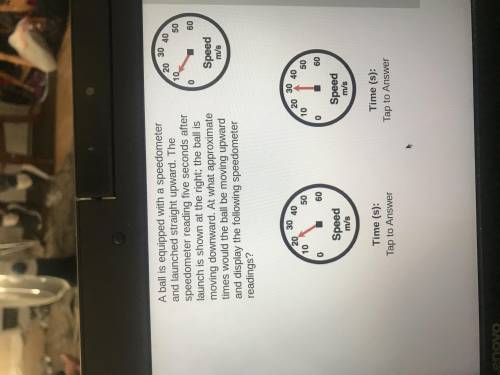
A ball is equipped with a speedometer and launched straight upward. The speedometer reading five seconds after launch is shown at the right; the ball is moving downward. At what approximate times would the ball be moving upward and display the following speedometer readings?


Answers: 2


Another question on Physics

Physics, 22.06.2019 00:20
Consider the particle-in-a-box problem in 1d. a particle with mass m is confined to move freely between two hard walls situated at x = 0 and x = l. the potential energy function is given as (a) describe the boundary conditions that must be satisfied by the wavefunctions ψ(x) (such as energy eigenfunctions). (b) solve the schr¨odinger’s equation and by using the boundary conditions of part (a) find all energy eigenfunctions, ψn(x), and the corresponding energies, en. (c) what are the allowed values of the quantum number n above? how did you decide on that? (d) what is the de broglie wavelength for the ground state? (e) sketch a plot of the lowest 3 levels’ wavefunctions (ψn(x) vs x). don’t forget to mark the positions of the walls on the graphs. (f) in a transition between the energy levels above, which transition produces the longest wavelength λ for the emitted photon? what is the corresponding wavele
Answers: 1

Physics, 22.06.2019 07:30
Some material consisting of a collection of microscopic objects is kept at a high temperature. a photon detector capable of detecting photon energies from infrared through ultraviolet observes photons emitted with energies of 0.3 ev, 0.5 ev, 0.8 ev, 2.0ev, 2.5ev, and 2.8ev. these are the only photon energies observed. (a) draw and label a possible energy-level diagram for one of the microscopic objects, which has four bound states. on the diagram, indicate the transitions corresponding to the emitted photons. explain briefly. (b) would a spring–mass model be a good model for these microscopic objects? why or why not? (c) the material is now cooled down to a very low temperature, and the photon detector stops detecting photon emissions. next, a beam of light with a continuous range of energies from infrared through ultraviolet shines on the material, and the photon detector observes the beam of light after it passes through the material. what photon energies in this beam of light are observed to be significantly reduced in intensity (“dark absorption lines”)? explain briefly.
Answers: 3

Physics, 22.06.2019 18:30
Which of the following is not a means to accelerating? question 4 options: a)increase speed b)remain still c)decrease speed d)change direction
Answers: 2

Physics, 22.06.2019 19:30
Which describes increasing the efficiency of energy resource
Answers: 1
You know the right answer?
A ball is equipped with a speedometer and launched straight upward. The speedometer reading five sec...
Questions


Mathematics, 20.08.2019 14:00



Mathematics, 20.08.2019 14:00



Mathematics, 20.08.2019 14:00


Biology, 20.08.2019 14:00

Business, 20.08.2019 14:00



Mathematics, 20.08.2019 14:00

Mathematics, 20.08.2019 14:00





History, 20.08.2019 14:00



